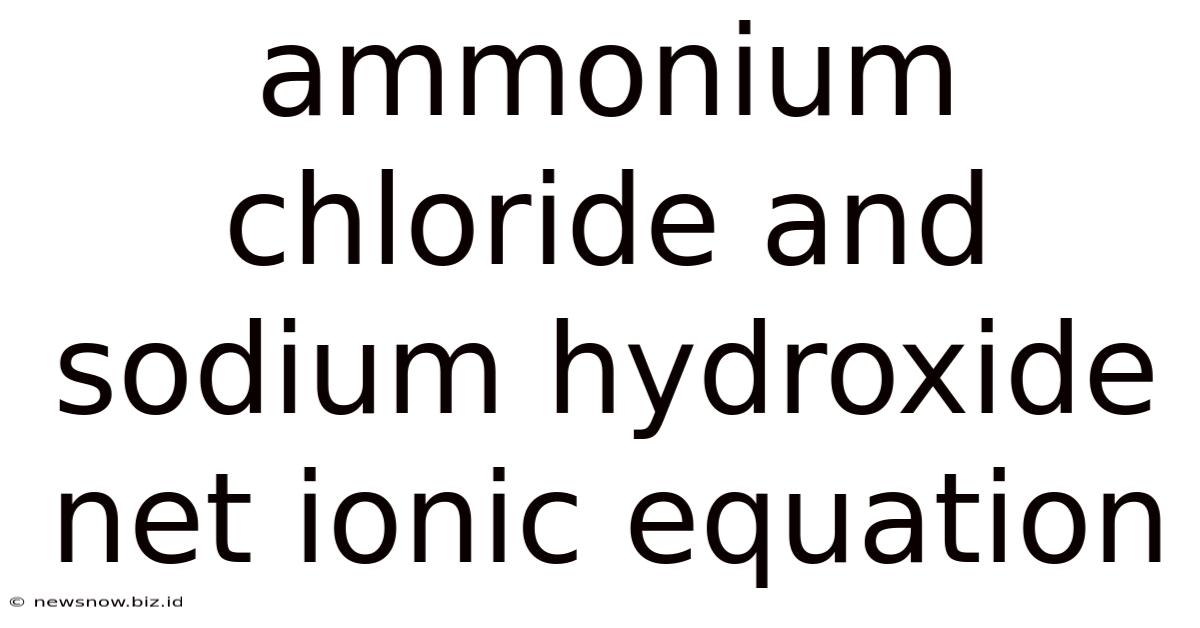Ammonium Chloride And Sodium Hydroxide Net Ionic Equation
New Snow
May 11, 2025 · 5 min read

Table of Contents
Ammonium Chloride and Sodium Hydroxide: A Deep Dive into the Net Ionic Equation
The reaction between ammonium chloride (NH₄Cl) and sodium hydroxide (NaOH) is a classic example of an acid-base neutralization reaction. Understanding this reaction, particularly its net ionic equation, is crucial for grasping fundamental concepts in chemistry, such as acid-base chemistry, spectator ions, and stoichiometry. This comprehensive guide will delve into the intricacies of this reaction, explaining the process step-by-step, and highlighting its significance in various contexts.
Understanding the Reactants
Before diving into the reaction itself, let's understand the individual components: ammonium chloride and sodium hydroxide.
Ammonium Chloride (NH₄Cl)
Ammonium chloride is a salt formed from the reaction of a weak acid (ammonium ion, NH₄⁺) and a strong acid (hydrochloric acid, HCl). It's a white crystalline salt, highly soluble in water. In aqueous solution, it dissociates completely into its constituent ions:
NH₄Cl(aq) → NH₄⁺(aq) + Cl⁻(aq)
The ammonium ion (NH₄⁺) is a weak acid, meaning it doesn't fully dissociate in water. It can donate a proton (H⁺) to water, resulting in a slightly acidic solution:
NH₄⁺(aq) + H₂O(l) ⇌ H₃O⁺(aq) + NH₃(aq)
This equilibrium lies significantly to the left, indicating that only a small fraction of ammonium ions donate protons.
Sodium Hydroxide (NaOH)
Sodium hydroxide, commonly known as lye or caustic soda, is a strong base. It readily dissociates completely in water, releasing sodium (Na⁺) and hydroxide (OH⁻) ions:
NaOH(aq) → Na⁺(aq) + OH⁻(aq)
The hydroxide ion (OH⁻) is a strong base, readily accepting protons (H⁺) from acids.
The Reaction: A Detailed Look
When ammonium chloride and sodium hydroxide solutions are mixed, a neutralization reaction occurs. The hydroxide ions from NaOH react with the ammonium ions from NH₄Cl. This reaction produces ammonia (NH₃), water (H₂O), and sodium chloride (NaCl).
NH₄Cl(aq) + NaOH(aq) → NH₃(aq) + H₂O(l) + NaCl(aq)
This is the complete balanced molecular equation. However, this equation doesn't fully represent what's happening at the ionic level. To get a clearer picture, we need to consider the ionic forms of the reactants and products.
The Complete Ionic Equation
The complete ionic equation shows all the ions present in the solution before and after the reaction. We write each soluble ionic compound as its constituent ions:
NH₄⁺(aq) + Cl⁻(aq) + Na⁺(aq) + OH⁻(aq) → NH₃(aq) + H₂O(l) + Na⁺(aq) + Cl⁻(aq)
Identifying and Eliminating Spectator Ions
Notice that sodium ions (Na⁺) and chloride ions (Cl⁻) appear on both the reactant and product sides of the complete ionic equation. These are spectator ions. They don't participate directly in the reaction; they simply remain in solution throughout the process. To obtain the net ionic equation, we eliminate these spectator ions:
NH₄⁺(aq) + OH⁻(aq) → NH₃(aq) + H₂O(l)
This is the net ionic equation for the reaction between ammonium chloride and sodium hydroxide. This equation concisely represents the actual chemical change that occurs during the neutralization reaction.
Significance of the Net Ionic Equation
The net ionic equation provides several crucial insights:
- Simplicity: It simplifies the representation of the reaction by focusing only on the species actively involved in the chemical change.
- Understanding the Chemistry: It reveals the fundamental chemical process occurring: the transfer of a proton (H⁺) from the ammonium ion to the hydroxide ion.
- Predicting Reactions: It helps in predicting the outcome of similar reactions involving weak acids and strong bases.
- Stoichiometric Calculations: It provides the stoichiometric ratios between the reactants and products, crucial for quantitative analysis.
Practical Applications and Further Considerations
The reaction between ammonium chloride and sodium hydroxide has several practical applications:
- Buffer Solutions: The reaction can be used to prepare buffer solutions, which resist changes in pH. This is because the resulting solution contains a mixture of a weak acid (NH₄⁺) and its conjugate base (NH₃).
- Cleaning Agents: The basic nature of sodium hydroxide makes it a component in various cleaning agents.
- Industrial Processes: Ammonium chloride and sodium hydroxide are used in various industrial processes, including the production of fertilizers and other chemicals.
- Analytical Chemistry: The reaction can be utilized in titrations to determine the concentration of either ammonium chloride or sodium hydroxide solutions.
Factors Affecting the Reaction
Several factors can influence the reaction rate and equilibrium:
- Concentration: Higher concentrations of reactants lead to a faster reaction rate.
- Temperature: Increasing the temperature generally increases the reaction rate.
- Presence of Catalysts: Catalysts can accelerate the reaction rate without being consumed themselves.
Beyond the Basics: Exploring Equilibrium and pH
The equilibrium of the reaction between ammonium ion and hydroxide ion is governed by the equilibrium constant, Kb, for the weak base ammonia. The pH of the resulting solution will depend on the initial concentrations of ammonium chloride and sodium hydroxide. If the concentrations are equal, the pH will be slightly basic because ammonia is a weak base. However, if one reactant is in excess, the pH will be determined by the excess reactant.
Conclusion
The reaction between ammonium chloride and sodium hydroxide, while seemingly simple, provides a rich opportunity to understand fundamental concepts in chemistry. The derivation and interpretation of its net ionic equation is essential for comprehending acid-base chemistry, spectator ions, and the nature of equilibrium reactions. Understanding this reaction lays the foundation for exploring more complex chemical phenomena and their practical applications in various fields. By focusing on the core chemical changes, the net ionic equation provides a powerful tool for chemists and students alike. Its simplicity belies the depth of chemical principles it encapsulates, making it a cornerstone of introductory chemistry education and beyond.
Latest Posts
Related Post
Thank you for visiting our website which covers about Ammonium Chloride And Sodium Hydroxide Net Ionic Equation . We hope the information provided has been useful to you. Feel free to contact us if you have any questions or need further assistance. See you next time and don't miss to bookmark.